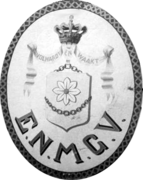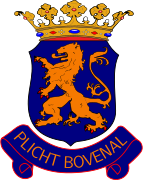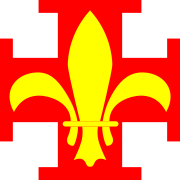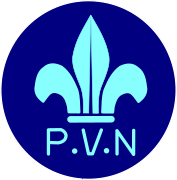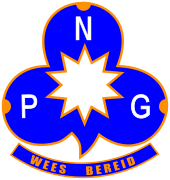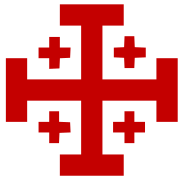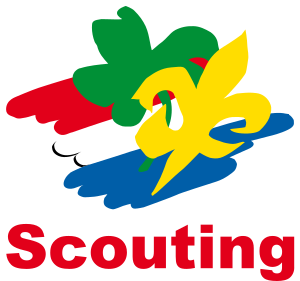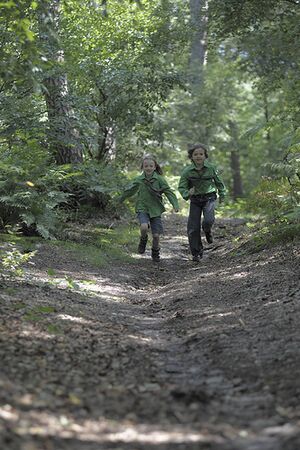Scouting Nederland: Difference between revisions
m (Robot: Removing from Category:Youth organisations based in the Netherlands) |
m (Bot: Converting bare references, using ref names to avoid duplicates, see FAQ) |
||
| (46 intermediate revisions by 6 users not shown) | |||
| Line 1: | Line 1: | ||
{{ThisPageWasImported}} | {{ThisPageWasImported}} | ||
{{Infobox WorldScouting | image = Scouting Nederland. | {{Infobox WorldScouting | ||
'''Scouting Nederland''' is the national [[Scouting|Scout]] organisation of [[ | |image=Scouting Nederland.svg | ||
|name = Scouting Nederland | |||
|headquarters = [[Leusden]] | |||
|country = [[Netherlands|the Netherlands]] | |||
|f-date = 1911 / 1973 | |||
| members = 110,000 | |||
| chiefscouttitle = Patron | |||
| chiefscout = [[Queen Máxima of The Netherlands|Princess Máxima]] | |||
| website = [http://www.scouting.nl www.scouting.nl] | |||
| affiliation =[[World Association of Girl Guides and Girl Scouts]],<br /> [[World Organization of the Scout Movement]] | |||
}} | |||
'''Scouting Nederland''' is the national [[Scouting|Scout]] organisation of the [[Netherlands]] with approximately 110,000 members (53,324 male<ref name="Census_2010">{{cite web |title=Triennal review: Census as at 1 December 2010|url=http://scout.org/en/content/download/22261/199900/file/Census.pdf |publisher=World Organization of the Scout Movement |accessdate=2011-01-13}}</ref> and 54,663 female, 87,000 youth members,<ref>{{cite web |title=Facts & figures |url=https://www.scouting.nl/index.php?option=com_content&task=view&id=59&Itemid=92 |publisher=Scouting Nederland |accessdate=2010-03-30}})</ref> as of 2010. | |||
The official [[patron]] of Scouting Nederland is Her Majesty [[Queen Máxima of The Netherlands]], the wife of the His Majesty The King of The Netherlands, [[Willem-Alexander]]. From 2005 is Scouting Nederland also affiliated to the [[International Scout and Guide Fellowship]], April 2011 the ISGF suspended that affiliation. | |||
[[ | |||
==History== | |||
Scouting for boys was started in the Netherlands in the summer of 1910 when the first Scout troops were formed in a few cities. Scouting started about a year later for girls. Dutch Scouts were among the founding members of [[World Association of Girl Guides and Girl Scouts]] in 1928 and also among the charter members of the [[World Organization of the Scout Movement]] in 1920. | |||
On 7 January 1911 the first national organisation was founded, the Nederlandsche Padvinders Organisatie (NPO, Netherlands Pathfinder Organisation). They merged with the Nederlandsche Padvinders Bond (NPB, Netherlands Pathfinder Federation) on 11 December 1915 and became known as De Nederlandse Padvinders (NPV, Netherlands Pathfinders). In 1933 some Scout Groups broke away from the NPV to form the Padvinders Vereniging Nederland (PVN, Pathfinder Association the Netherlands), because difficulties concerning the [[Scout Promise]] arose. The difficulty was that boys who recognised no god still had to promise "To do my duty to God and my country". The Scout Groups found that one grew hypocrites this way. The NPV and the PVN almost reunited in 1940. The PVN was not refounded after World War II. Although the NPV was open to boys of all religions, a Roman Catholic organisation was founded in 1930, the Katholieke Verkenners (KV, Catholic Scouts). First inside the NPV, but after 1938 as a separate organisation. After World War II the Roman Catholic Church wanted to merge all Roman Catholic youth organisations. After negotiations the Katholieke Verkenners were allowed to go on as Verkenners van de Katholieke Jeugdbeweging (Scouts of the Catholic youth movement). The Katholieke Verkenners became a separate organisation again in 1961. | |||
Girls got their first own organisation in 1911, Eerste Nederlandsche Meisjes Gezellen Vereeniging (E.N.M.G.V., First Dutch Girls Companions Society), but this organisation never got many members. Girls had also been member of the NPO but the NPV was boys only. On 16 January 1916 the Het Nederlandsche Meisjesgilde (NMG, Dutch Girls Guild) started, which later changed its name to Het Nederlandse Padvindsters Gilde (NPG, Dutch Girl-pathfinders Guild), followed in 1945 by the founding of a separate Catholic organisation, the Nederlandse Gidsenbeweging (NGB, Dutch Guide Movement), which later changed its name to Nederlandse Gidsen (NG, Dutch Guides). | |||
During [[World War II]] all Scouting movements were prohibited in the Netherlands, because the organizations refused to merge with ''Youth Storm'', the [[National Socialist Movement in the Netherlands|Dutch National Socialist]] youth organization. Still, many continued their activities secretly. After the end of the war, Scouting again became very popular and therefore many of the current local Scout Groups in the Netherlands were founded in 1945 or 1946. | |||
During [[World War II]] all Scouting movements were prohibited and officially dissolved in the Netherlands, because the organizations refused to merge with ''Youth Storm'', the [[National Socialist Movement in the Netherlands|Dutch National Socialist]] youth organization. Still, many continued their activities secretly. After the end of the war, Scouting again became very popular and therefore many of the current local Scout Groups in the Netherlands were founded in 1945 or 1946. | |||
The four separate organisations (NPV, KV, NPG and NG) existed until 1973, when they all merged into ''Scouting Nederland'' (SN). | The four separate organisations (NPV, KV, NPG and NG) existed until 1973, when they all merged into ''Scouting Nederland'' (SN). | ||
The | ===Emblems=== | ||
<gallery mode=packed> | |||
File:Nederlandsche Padvinders Organisatie.png|Emblem of De Nederlandsche Padvinders Organisatie<br />1911 - 1915 | |||
File:Eerste Nederlandsche Meisjes Gezellen Vereeniging.png|Emblem of Eerste Nederlandsche Meisjes Gezellen Vereeniging<br />1911 - ~ 1916 | |||
File:Nederlandsche Padvindersbond.svg|Emblem of De Nederlandsche Padvindersbond<br />1912 - 1915 | |||
File:LdH Padvindersbond.png| Emblem of Leger des Heils Padvindersbond | |||
File:LdH Padvindstersbond.png| Emblem of Leger des Heils Padvindstersbond | |||
File:De_Nederlandsche_Padvinders.png|Emblem of De Nederlandse Padvinders<br />1929 - 1973 | |||
File:Katholieke Verkenners.svg|Emblem of De Katholieke Verkenners <br />1930 - 1946 and<br />1961 - 1973 | |||
File:Padvinders Vereeniging Nederland.svg|Emblem of Padvinders Vereeniging Nederland <br />1933 - 1940 | |||
File:Het Nederlandse Padvindstersgilde.svg|Emblem of Het Nederlandse Padvindstersgilde <br /> 1936 - 1973 | |||
File:Croix de l Ordre du Saint-Sepulcre.svg|Emblem (Verkenners van) de Katholieke Jeugdbeweging <br />1946 - 1961 | |||
</gallery> | |||
The emblem of "De Nederlandse Padvinders" consisted of a [[Fleur-de-lis]] and a banner with the [[Scout Motto]] "Weest Paraat" . The emblem of "Het Nederlandse Padvindstersgilde" (NPG) consisted of a ten point white star for the ten lines in the Girl Scouts law on a blue Trefoil for Girl Scouting/Guiding with the Scout Motto "Wees Bereid", variants are still in use by [[Surinaamse Padvindsters Raad|Het Surinaamse Padvindsters Gilde]], [[Het Arubaanse Padvindsters Gilde]] and [[Padvindstersvereniging van de Nederlandse Antillen]]. Before 1936 the NPG had the same emblem with an eight point star because of an eight point law. Het Nederlandsche Meisjesgilde had the same emblem with an eight point star but with the letters NMG. The emblem of the "Katholieke Verkenners" , consisted of a Fleur-de-lis for Boy Scouts, on a cross potent for Catholic Scouts, a variant was used by the [[Boy Scouts van Suriname|Katholieke Verkenners Suriname]]. The emblem of the Nederlandse Gidsen (Beweging) consisted of a light blue Trefoil for Girl Scouting/Guiding on a yellow Cross potent for Roman Catholic Scouting/Guiding, a variant is still in use by the [[Surinaamse Padvindsters Raad|Gidsen Suriname]]. | |||
===Law=== | |||
'''Het Nederlandsche Meisjesgilde / Het Nederlandse Padvindstersgilde 1916-1936''' | |||
* Be much (help) at home | |||
* Do not despise any kind of work | |||
* Be honest and faithful | |||
* Be helpful for human and animal | |||
* Speak and think no harm | |||
* Obey without complaining | |||
* Wear disappointment with cheerfulness | |||
* Care for your health | |||
The NPG after 1936 and the NPV, KV, and NG had a law based on the [[Scout Law]]. | |||
==Dutch recipients of the Silver Wolf Award== | |||
*[[Jean Jacques Rambonnet]] - chairman N.P.V., Chief Scout | |||
*Arie E. Oosterlee - May 1938 - Head quarter commissioner N.P.V. | |||
==Motto, Promise and Law== | ==Motto, Promise and Law== | ||
===Scout Motto=== | ===Scout Motto=== | ||
The | The [[Scout Motto]] is in not much use after the merger. The Motto before the merger was for Cub Scouts was ''Doe je best'', for Boy Scouts ''Weest Paraat'' and for Girl Guides ''Wees Bereid''. | ||
===Scout Promise=== | ===Scout Promise=== | ||
The Dutch [[Scout Promise]] is one of the few in the world where the reference to God is optional. It makes the Netherlands an exception to the WOSM guidelines. The Constitution of WOSM states that the Promise should include a reference to Duty to God | The Dutch [[Scout Promise]] is one of the few in the world where the reference to God is optional. It makes the Netherlands an exception to the WOSM guidelines. The Constitution of WOSM states that the Promise should include a reference to Duty to God,<ref>{{cite web | ||
|title=Constitution and By-Laws of the World Organization of the Scout Movement | |||
|author=WOSM | |||
|date=July 2008 | |||
|page=5 | |||
|accessdate=6 August 2009 | |||
|url=http://www.scout.org/en/content/download/13661/118988/file/WOSMconstitutionE.pdf | |||
|authorlink=World Organization of the Scout Movement | |||
}}</ref> but six countries, including the Netherlands were granted the right in the 1920s by [[Lord Baden-Powell]] to additionally use an ''alternative promise'' without a reference to God.<ref name="FundPrinc">{{cite web | |||
|title=Report on the Discussion on the Fundamental Principles of WAGGGS and WOSM | |||
|author=[[World Organization of the Scout Movement|WOSM]] and [[WAGGGS]] | |||
|date=13 June 2001 | |||
|pages=7–8 | |||
|accessdate=6 August 2009 | |||
|url=http://www.ppoe.at/scoutdocs/relationships/wagggs_wosm_rel.pdf | |||
}}</ref> | |||
WOSM decided in 1932 that no new exceptions would be made and expressed the hope that the few remaining countries would stop using any promise lacking a reference to Duty to God.<ref name="FundPrinc"/> | |||
{| class='wikitable' style="border:2px solid #8888aa; background-color:#f7f8ff; padding:5px; font-size:95%; margin: 0px 12px 12px 0px; vertical-align : top; width: 100%" | |||
|- valign="top" | |||
!Section | |||
!Dutch | |||
!English translation | |||
|- | |||
|Beavers | |||
| | |||
|No official Promise (Some groups made their own promise) | |||
|- | |||
|Esta<br />Brownie<br />Cub Scout<br />Dolphin | |||
|Ik beloof mijn best te doen<br />(met de hulp van God)<br />een goede Esta / Welp / Kabouter / Dolfijn te zijn,<br />iedereen te helpen waar ik kan<br />en me te houden aan de Esta- / Welpen- / Kabouter- / Dolfijnen-wet.<br />Jullie kunnen op me rekenen. | |||
|I promise to do my best<br />(with the help of God)<br />to be a good Esta / Cub Scout / Brownie / Dolphin<br />to help everyone where I can<br />and to live by the Esta / Brownie / Cub Scout / Dolphin law.<br />You can count on me. | |||
|- | |||
|Scouts | |||
|Ik beloof mijn best te doen<br />(met de hulp van God)<br />een goede Scout te zijn,<br />bewust het goede te zoeken en te bevorderen,<br />iedereen te helpen waar ik kan<br />en me te houden aan de Scouts-wet.<br />Jullie kunnen op me rekenen. | |||
|I promise to do my best<br />(with the help of God)<br />to be a good Scout<br />to search for and encourage the good consciously,<br />to help everyone where I can<br />and to live by the scouts law.<br />You can count on me. | |||
|- | |||
|Explorers<br />(Declaration of Willingness) | |||
|Als Explorer wil ik samen met anderen<br />de wereld om mij heen ontdekken<br />en meer leefbaar maken.<br />Met de inzet van mijn mogelijkheden<br />en met eerbied voor alles wat leeft<br />wil ik de kansen die ik krijg benutten.<br />Ik probeer zo goed mogelijk om te gaan<br />met de middelen die mij ter beschikking staan<br />en ik respecteer mijzelf en anderen. | |||
|Being an Explorer I want, together with others,<br />explore the world around me<br />and to make this world a better place to live in.<br />with the use of all my talents<br />and with respect for all that lives<br />I want to make use of the chances I get.<br />I try and cope as best as I can<br />with the means that are available<br />and I respect myself and others | |||
|- | |||
|Adolescents<br />(Manifest) | |||
|De jongeren van Scouting Nederland<br />streven er naar door samen te ontdekken<br />te bezinnen en te dienen<br />zich open te stellen en in te zetten voor hun medemens. | |||
|By exploring together<br />the adolescents of Scouting Nederland<br />aim at reflecting and serving,<br />to open up and get into action for their fellow man | |||
|- | |||
|Leaders | |||
|Ik beloof mijn best te doen<br />(met de hulp van God)<br />voor jullie een goede leider/leidster te zijn<br />en jullie te helpen een goede Bever / Esta / Kabouter / Welp / Dolfijn / Scout / Explorer te zijn.<br />Ik beloof ook bewust het goede te zoeken en te bevorderen.<br />Ik wil dit doen samen met de andere leiding van de .... groep.<br />Jullie kunnen op me rekenen. | |||
|I promise to do my best<br />(with the help of God)<br />to be a good leader for you<br />and to help you being a good Beaver / Esta / Brownie / Cub Scout / Dolphin / Scout / Explorer <br />I also promise to search for and encourage the good consciously,<br />I would like to do that together with the other leaders of the .... group.<br />You can count on me. | |||
|} | |||
===Scout Law=== | |||
All Dutch Scouts pledge faith to the [[Scout Law]] in their Scout Promise. | |||
{| class='wikitable' style="border:2px solid #8888aa; background-color:#f7f8ff; padding:5px; font-size:95%; margin: 0px 12px 12px 0px; vertical-align : top; width: 100%" | |||
|- valign="top" | |||
!Section | |||
!Dutch | |||
!English translation | |||
|- | |||
|Beavers | |||
| | |||
|No Law | |||
|- | |||
|Esta<br />Brownie<br />Cub Scout<br />Dolphin | |||
|Een Esta / Welp / Kabouter / Dolfijn speelt samen<br />met anderen in het Land van Esta / in de Rimboe / in Bambilië / op en rond het water.<br />Hij / Zij is eerlijk, vriendelijk<br />en houdt vol<br />en zorgt goed voor de natuur. | |||
|An Esta / Cub Scout / Brownie / Dolphin plays together<br />with others in Esta Land / in the Jungle / in Bambilië / in and around the water<br />He / She is honest and kind<br />He / She perseveres<br />and takes good care of nature. | |||
|- | |||
|Scouts | |||
|Een Scout trekt er samen<br />met anderen op uit<br />om de wereld om zich heen te ontdekken<br />en deze meer leefbaar te maken.<br />Hij/Zij is eerlijk, trouw, en houdt vol.<br />Hij/Zij is spaarzaam en sober<br />en heeft zorg voor de natuur.<br />Hij/Zij respecteert zichzelf en anderen. | |||
|A scout ventures out into the world<br />together with others<br />to explore the world around him / her<br />and to make it a better place to live in.<br />He / she is honest, loyal and will persevere.<br />He / She is thrifty and plain<br />and cares for nature.<br />He / She respects him / herself and others | |||
|} | |||
==Programme== | |||
Scouting Nederland is open for everyone irrespective of belief, race, skin colour, handicap, political context, sexual preference, or age. Scouting Nederland is [[co-education]]al and open, but single sex [[Scout Group]]s and Scout Groups with a religion are allowed. | |||
In the Netherlands, most Scout groups are regular Scouts, but special programmes have been developed also for [[Sea Scouts|Water Scouts]] and [[Air Scouts]]. Apart from the standard age groups, Scouting in the Netherlands has a separate division for handicapped members, called the ''Blauwe Vogels'' (BV, ([[L'Oiseau Bleu|Blue Birds]]) or ''Bijzondere Eisen'' (BE, [[Special Needs]]). | |||
The [[Crown Scout]] rank was the highest a Boy Scout could achieve in the Netherlands, until the mid 1970s. | |||
== | ===Regular Scouts=== | ||
[[File:Logo Scouting Nederland.svg|thumb|Logo of Scouting Nederland]] | |||
The regular Dutch Scouting programme is divided into several age groups, although some age groups partly overlap and there are multiple programmes for some age groups.<ref>{{cite web|title=Nooit meer kabouter, gidsen, rowan of pivo |url=https://www.scouting.nl/index.php?option=com_content&task=view&id=1004&Itemid=428|accessdate =2009-12-14|publisher=Scouting Nederland|language=nl}}</ref> | |||
The [[ | The age group for ages 5 to 7 is called ''Bevers'' ([[Beavers (Scouting)|Beavers]]). | ||
For ages between 7 to 11 the programme is called ''Welpen'' ([[Cub Scouts|Cubs]]). Until 2010 there were also ''Kabouters'' ([[Brownies (Girl Guides)|Brownies]]), mostly for girls and ''Esta's'' for co-educational groups. These programmes and the "Dolfijnen" are being replaced by a redesigned ''Welpen'' programme with a second main character, the girl Shanti, and more water animals. | |||
[[ | |||
The age group 11 to 15 is called ''Scouts'', but often the old, now unofficial, names ''Verkenners'' ([[Boy Scout]]s), ''Padvindsters'' or ''Gidsen'' ([[Girl Guide and Girl Scout|Girl Scout/Guide]]) are used. | |||
The age group for ages 15 to 18 is called ''Explorers'', but often the old, now unofficial, names ''Rowans'' for boys and ''Sherpa's'' for girls are used. | |||
The age group for ages 18 to 21 is called "Roverscouts", before 2010 "Jongerentak", but more often the name "stam" (crew) is used or the old, now unofficial, name ''Pivo's" (Pionier(st)er/Voortrekker [[Ranger Guides|Ranger]]/[[Rover Scouts|Rover]])'' | |||
The age group above 21 is called ''Plusscouts''. | |||
=== | ===Water Scouts=== | ||
[[Image:Lelievlet zeilteken.svg|140px|thumb|Sail emblem Lelievlet]] | [[Image:Lelievlet zeilteken.svg|140px|thumb|Sail emblem Lelievlet]] | ||
In the Netherlands there are about 300 <ref>{{cite web | last = | first = | authorlink = | coauthors = | year = | url = http://europe.seascout.org/eurosea/8/presentations/Dutch_Sea_Scouts.ppt | title = Presentation Dutch Seascouts Eurosea 8 Seminar| format = powerpoint | work = | publisher = | accessdate = 2007-03-05}}</ref> Sea Scout Groups. Approximately 32 % of the | In the Netherlands there are about 300 <ref>{{cite web | last = | first = | authorlink = | coauthors = | year = | url = http://europe.seascout.org/eurosea/8/presentations/Dutch_Sea_Scouts.ppt | title = Presentation Dutch Seascouts Eurosea 8 Seminar| format = powerpoint | work = | publisher = | accessdate = 2007-03-05}}</ref> Sea Scout Groups. Because the dutch scouts are sailing on all kinds of water (not only "Sea") they speak about "Water Scout" instead of Sea Scouts. Approximately 32 % of the Water Scouts are girls. The total fleet of all Dutch water scout groups consists of 54 [[guard ship]]s, 120 [[tugboat]]s and [[motorboat]]s, 100 ''[[Lelieschouw]]en'', 1,550 ''[[Lelievlet]]ten'' (iron [[sailboat]] for 6 persons) and 40 ''[[Juniorvlet]]ten'' (smaller size of the Lelievlet). Sea Scouting has its own sections for many age groups, but [[Cub Scout]] and [[Beavers (Scouting)|Beaver Scout]] Sections can also be a part of the Group. Officially, there are specialized water scout programs for 12 years and older. | ||
Until 2010 there was a special water programme for age 8 to 11, Dolfijnen (Dolphins). This is being replaced by a redesigned ''Welpen'' programme with a second main character, the girl Shanti, and more water animals. | |||
Members are called ''Water Scouts'' from 12 to 16 years or more often ''Zeeverkenners'', a unit is referred to as ''Wacht'' (''[[Watch | Members are called ''Water Scouts'' from 12 to 16 years or more often ''Zeeverkenners'', a unit is referred to as ''Wacht'' (''[[Watch system|Watch]]''). The adult leaders are called ''Schipper'' (''[[Skipper (boating)|Skipper]]'') and ''Stuurman'' (''[[Coxswain]]''). A ''patrol'' is called ''bak'', its leader ''Boots(man)'' and his/her assistant ''Kwartiermeester''. Water Scouts (which number 5,400 in the Netherlands) use Juniorvletten or Lelievletten. | ||
The ''(Matrozen ter) Wilde Vaart'' (''[[sailor]]s of the high [[sea]]s'' in English) are the Sea Scouting version of Explorers, a unit is referred to as ''Afdeling'' Wilde Vaart uses Lelievletten or Lelieschouwen. The 1,400 members are aged between 16 and 18 years. | The ''(Matrozen ter) Wilde Vaart'' (''[[sailor]]s of the high [[sea]]s'' in English) are the Sea Scouting version of Explorers, a unit is referred to as ''Afdeling'' Wilde Vaart uses Lelievletten or Lelieschouwen. The 1,400 members are aged between 16 and 18 years. | ||
| Line 68: | Line 171: | ||
===Air Scouts=== | ===Air Scouts=== | ||
Being not very common, there are only about 15 Air Scout groups in the Netherlands. At the scouts age (10-15), they are called ''Luchtscouts'' and Air Scout Explorers are called ''Astronauten'' ([[Astronauts]]). | Being not very common, there are only about 15 [[Air Scouts|Air Scout]] groups in the Netherlands. At the scouts age (10-15), they are called ''Luchtscouts'' or ''Luchtverkenners'' and Air Scout Explorers are called ''Astronauten'' ([[Astronauts]]). | ||
== | ===Camping=== | ||
The | The Northern Pinkster Camp (Dutch: Noordelijk Pinksterkamp or NPK) is a Scouting camp held on the [[Military education and training|military practice terrain]] [[Marnewaard]] in the province of [[Groningen (province)|Groningen]]. The camp is held every year at [[Pentecost]]. The camp is held for members of Scouting Nederland from the northern Netherlands provinces of [[Friesland]], Groningen and [[Drenthe]]. | ||
The Northern Pinkster Camp is the largest annual Scouting camp of the Netherlands and one of the largest of the whole of Europe<ref>[http://www.noordelijkpinksterkamp.nl/npk/kamp Kampboekje 2023 - Noordelijk Pinksterkamp<!-- Bot generated title -->]</ref>. In [[2007]] when the camp was held there were almost 3500 participants. | |||
==Uniform== | |||
[[File:Welpen-in-het-bos.jpg|thumb|Welpen of Scouting Nederland]] | |||
The official uniform of all Scouts in the Netherlands consists of blue trousers, a light blue [[t-shirt]], a light blue [[sweater]] or a [[shirt]], a [[neckerchief]] that is different between Scout Groups and optionally a cap. The shirt differs between the different age groups, the ages 5 to 8 can wear a red shirt, the ages 7 to 11 a light green shirt, the ages 10 to 15 a [[khaki]] shirt and the ages above 14 a dark red/violet ("brick") shirt. Apart from that, all [[Sea Scouts]] can wear a dark blue shirt and all [[Air Scouts]] can wear a light gray shirt. | |||
==References== | ==References== | ||
{{Reflist}} | |||
<references /> | <references /> | ||
==External links== | |||
* [http://www.scouting.nl/ Official Homepage of Scouting Nederland] | * [http://www.scouting.nl/ Official Homepage of Scouting Nederland] | ||
* [http://www.scouting.nl/static/algemeen/geschiedenis_en.html A brief history of Scouting Nederland] | * [http://www.scouting.nl/static/algemeen/geschiedenis_en.html A brief history of Scouting Nederland] | ||
* [http://www.kelpin.nl/fred/padvinderskroniek.htm Piet Kroonenbergs Padvinderskroniek] | * [http://www.kelpin.nl/fred/padvinderskroniek.htm Piet Kroonenbergs Padvinderskroniek] | ||
* [http://www.scoutquest.com/nl/scout/hist/geschiedenis01.shtml Hoe scouting ontstond (Dutch)] | * [http://www.scoutquest.com/nl/scout/hist/geschiedenis01.shtml Hoe scouting ontstond (Dutch)] | ||
* [http://nl.scoutwiki.org/ Dutch Scoutwiki] | |||
* [http://www.noordelijkpinksterkamp.nl/ Official site 'Northern Pinkster Camp'](Dutch) | |||
{{Scouting Sections | |||
|organization=Scouting Nederland | |||
|sectionA=Bevers | |||
|sectionB=Welpen | |||
|sectionC=Scouts | |||
|sectionD=Explorers | |||
|sectionE=Roverscouts | |||
|SectionF=Plusscouts | |||
}} | |||
{{EuropeanScout}} | {{EuropeanScout}} | ||
| Line 99: | Line 211: | ||
[[Category:WAGGGS member organizations]] | [[Category:WAGGGS member organizations]] | ||
[[Category:WOSM member organizations]] | [[Category:WOSM member organizations]] | ||
[[Category:Scouting in | [[Category:Scouting and Guiding in the Netherlands]] | ||
[[fr:Scouting Nederland]] | |||
[[nl:Scouting Nederland]] | [[nl:Scouting Nederland]] | ||
Latest revision as of 23:16, 31 December 2023
| Scouting Nederland | |||
|---|---|---|---|
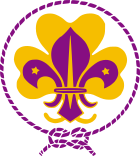 | |||
| Headquarters | Leusden | ||
| Country | the Netherlands | ||
| Founded | 1911 / 1973 | ||
| Membership | 110,000 | ||
| Patron | Princess Máxima | ||
| Affiliation |
World Association of Girl Guides and Girl Scouts, World Organization of the Scout Movement | ||
|
| |||
|
Website www.scouting.nl | |||
Scouting Nederland is the national Scout organisation of the Netherlands with approximately 110,000 members (53,324 male[1] and 54,663 female, 87,000 youth members,[2] as of 2010.
The official patron of Scouting Nederland is Her Majesty Queen Máxima of The Netherlands, the wife of the His Majesty The King of The Netherlands, Willem-Alexander. From 2005 is Scouting Nederland also affiliated to the International Scout and Guide Fellowship, April 2011 the ISGF suspended that affiliation.
History
Scouting for boys was started in the Netherlands in the summer of 1910 when the first Scout troops were formed in a few cities. Scouting started about a year later for girls. Dutch Scouts were among the founding members of World Association of Girl Guides and Girl Scouts in 1928 and also among the charter members of the World Organization of the Scout Movement in 1920.
On 7 January 1911 the first national organisation was founded, the Nederlandsche Padvinders Organisatie (NPO, Netherlands Pathfinder Organisation). They merged with the Nederlandsche Padvinders Bond (NPB, Netherlands Pathfinder Federation) on 11 December 1915 and became known as De Nederlandse Padvinders (NPV, Netherlands Pathfinders). In 1933 some Scout Groups broke away from the NPV to form the Padvinders Vereniging Nederland (PVN, Pathfinder Association the Netherlands), because difficulties concerning the Scout Promise arose. The difficulty was that boys who recognised no god still had to promise "To do my duty to God and my country". The Scout Groups found that one grew hypocrites this way. The NPV and the PVN almost reunited in 1940. The PVN was not refounded after World War II. Although the NPV was open to boys of all religions, a Roman Catholic organisation was founded in 1930, the Katholieke Verkenners (KV, Catholic Scouts). First inside the NPV, but after 1938 as a separate organisation. After World War II the Roman Catholic Church wanted to merge all Roman Catholic youth organisations. After negotiations the Katholieke Verkenners were allowed to go on as Verkenners van de Katholieke Jeugdbeweging (Scouts of the Catholic youth movement). The Katholieke Verkenners became a separate organisation again in 1961.
Girls got their first own organisation in 1911, Eerste Nederlandsche Meisjes Gezellen Vereeniging (E.N.M.G.V., First Dutch Girls Companions Society), but this organisation never got many members. Girls had also been member of the NPO but the NPV was boys only. On 16 January 1916 the Het Nederlandsche Meisjesgilde (NMG, Dutch Girls Guild) started, which later changed its name to Het Nederlandse Padvindsters Gilde (NPG, Dutch Girl-pathfinders Guild), followed in 1945 by the founding of a separate Catholic organisation, the Nederlandse Gidsenbeweging (NGB, Dutch Guide Movement), which later changed its name to Nederlandse Gidsen (NG, Dutch Guides).
During World War II all Scouting movements were prohibited and officially dissolved in the Netherlands, because the organizations refused to merge with Youth Storm, the Dutch National Socialist youth organization. Still, many continued their activities secretly. After the end of the war, Scouting again became very popular and therefore many of the current local Scout Groups in the Netherlands were founded in 1945 or 1946.
The four separate organisations (NPV, KV, NPG and NG) existed until 1973, when they all merged into Scouting Nederland (SN).
Emblems
The emblem of "De Nederlandse Padvinders" consisted of a Fleur-de-lis and a banner with the Scout Motto "Weest Paraat" . The emblem of "Het Nederlandse Padvindstersgilde" (NPG) consisted of a ten point white star for the ten lines in the Girl Scouts law on a blue Trefoil for Girl Scouting/Guiding with the Scout Motto "Wees Bereid", variants are still in use by Het Surinaamse Padvindsters Gilde, Het Arubaanse Padvindsters Gilde and Padvindstersvereniging van de Nederlandse Antillen. Before 1936 the NPG had the same emblem with an eight point star because of an eight point law. Het Nederlandsche Meisjesgilde had the same emblem with an eight point star but with the letters NMG. The emblem of the "Katholieke Verkenners" , consisted of a Fleur-de-lis for Boy Scouts, on a cross potent for Catholic Scouts, a variant was used by the Katholieke Verkenners Suriname. The emblem of the Nederlandse Gidsen (Beweging) consisted of a light blue Trefoil for Girl Scouting/Guiding on a yellow Cross potent for Roman Catholic Scouting/Guiding, a variant is still in use by the Gidsen Suriname.
Law
Het Nederlandsche Meisjesgilde / Het Nederlandse Padvindstersgilde 1916-1936
- Be much (help) at home
- Do not despise any kind of work
- Be honest and faithful
- Be helpful for human and animal
- Speak and think no harm
- Obey without complaining
- Wear disappointment with cheerfulness
- Care for your health
The NPG after 1936 and the NPV, KV, and NG had a law based on the Scout Law.
Dutch recipients of the Silver Wolf Award
- Jean Jacques Rambonnet - chairman N.P.V., Chief Scout
- Arie E. Oosterlee - May 1938 - Head quarter commissioner N.P.V.
Motto, Promise and Law
Scout Motto
The Scout Motto is in not much use after the merger. The Motto before the merger was for Cub Scouts was Doe je best, for Boy Scouts Weest Paraat and for Girl Guides Wees Bereid.
Scout Promise
The Dutch Scout Promise is one of the few in the world where the reference to God is optional. It makes the Netherlands an exception to the WOSM guidelines. The Constitution of WOSM states that the Promise should include a reference to Duty to God,[3] but six countries, including the Netherlands were granted the right in the 1920s by Lord Baden-Powell to additionally use an alternative promise without a reference to God.[4] WOSM decided in 1932 that no new exceptions would be made and expressed the hope that the few remaining countries would stop using any promise lacking a reference to Duty to God.[4]
| Section | Dutch | English translation |
|---|---|---|
| Beavers | No official Promise (Some groups made their own promise) | |
| Esta Brownie Cub Scout Dolphin |
Ik beloof mijn best te doen (met de hulp van God) een goede Esta / Welp / Kabouter / Dolfijn te zijn, iedereen te helpen waar ik kan en me te houden aan de Esta- / Welpen- / Kabouter- / Dolfijnen-wet. Jullie kunnen op me rekenen. |
I promise to do my best (with the help of God) to be a good Esta / Cub Scout / Brownie / Dolphin to help everyone where I can and to live by the Esta / Brownie / Cub Scout / Dolphin law. You can count on me. |
| Scouts | Ik beloof mijn best te doen (met de hulp van God) een goede Scout te zijn, bewust het goede te zoeken en te bevorderen, iedereen te helpen waar ik kan en me te houden aan de Scouts-wet. Jullie kunnen op me rekenen. |
I promise to do my best (with the help of God) to be a good Scout to search for and encourage the good consciously, to help everyone where I can and to live by the scouts law. You can count on me. |
| Explorers (Declaration of Willingness) |
Als Explorer wil ik samen met anderen de wereld om mij heen ontdekken en meer leefbaar maken. Met de inzet van mijn mogelijkheden en met eerbied voor alles wat leeft wil ik de kansen die ik krijg benutten. Ik probeer zo goed mogelijk om te gaan met de middelen die mij ter beschikking staan en ik respecteer mijzelf en anderen. |
Being an Explorer I want, together with others, explore the world around me and to make this world a better place to live in. with the use of all my talents and with respect for all that lives I want to make use of the chances I get. I try and cope as best as I can with the means that are available and I respect myself and others |
| Adolescents (Manifest) |
De jongeren van Scouting Nederland streven er naar door samen te ontdekken te bezinnen en te dienen zich open te stellen en in te zetten voor hun medemens. |
By exploring together the adolescents of Scouting Nederland aim at reflecting and serving, to open up and get into action for their fellow man |
| Leaders | Ik beloof mijn best te doen (met de hulp van God) voor jullie een goede leider/leidster te zijn en jullie te helpen een goede Bever / Esta / Kabouter / Welp / Dolfijn / Scout / Explorer te zijn. Ik beloof ook bewust het goede te zoeken en te bevorderen. Ik wil dit doen samen met de andere leiding van de .... groep. Jullie kunnen op me rekenen. |
I promise to do my best (with the help of God) to be a good leader for you and to help you being a good Beaver / Esta / Brownie / Cub Scout / Dolphin / Scout / Explorer I also promise to search for and encourage the good consciously, I would like to do that together with the other leaders of the .... group. You can count on me. |
Scout Law
All Dutch Scouts pledge faith to the Scout Law in their Scout Promise.
| Section | Dutch | English translation |
|---|---|---|
| Beavers | No Law | |
| Esta Brownie Cub Scout Dolphin |
Een Esta / Welp / Kabouter / Dolfijn speelt samen met anderen in het Land van Esta / in de Rimboe / in Bambilië / op en rond het water. Hij / Zij is eerlijk, vriendelijk en houdt vol en zorgt goed voor de natuur. |
An Esta / Cub Scout / Brownie / Dolphin plays together with others in Esta Land / in the Jungle / in Bambilië / in and around the water He / She is honest and kind He / She perseveres and takes good care of nature. |
| Scouts | Een Scout trekt er samen met anderen op uit om de wereld om zich heen te ontdekken en deze meer leefbaar te maken. Hij/Zij is eerlijk, trouw, en houdt vol. Hij/Zij is spaarzaam en sober en heeft zorg voor de natuur. Hij/Zij respecteert zichzelf en anderen. |
A scout ventures out into the world together with others to explore the world around him / her and to make it a better place to live in. He / she is honest, loyal and will persevere. He / She is thrifty and plain and cares for nature. He / She respects him / herself and others |
Programme
Scouting Nederland is open for everyone irrespective of belief, race, skin colour, handicap, political context, sexual preference, or age. Scouting Nederland is co-educational and open, but single sex Scout Groups and Scout Groups with a religion are allowed.
In the Netherlands, most Scout groups are regular Scouts, but special programmes have been developed also for Water Scouts and Air Scouts. Apart from the standard age groups, Scouting in the Netherlands has a separate division for handicapped members, called the Blauwe Vogels (BV, (Blue Birds) or Bijzondere Eisen (BE, Special Needs).
The Crown Scout rank was the highest a Boy Scout could achieve in the Netherlands, until the mid 1970s.
Regular Scouts
The regular Dutch Scouting programme is divided into several age groups, although some age groups partly overlap and there are multiple programmes for some age groups.[5]
The age group for ages 5 to 7 is called Bevers (Beavers).
For ages between 7 to 11 the programme is called Welpen (Cubs). Until 2010 there were also Kabouters (Brownies), mostly for girls and Esta's for co-educational groups. These programmes and the "Dolfijnen" are being replaced by a redesigned Welpen programme with a second main character, the girl Shanti, and more water animals.
The age group 11 to 15 is called Scouts, but often the old, now unofficial, names Verkenners (Boy Scouts), Padvindsters or Gidsen (Girl Scout/Guide) are used.
The age group for ages 15 to 18 is called Explorers, but often the old, now unofficial, names Rowans for boys and Sherpa's for girls are used.
The age group for ages 18 to 21 is called "Roverscouts", before 2010 "Jongerentak", but more often the name "stam" (crew) is used or the old, now unofficial, name Pivo's" (Pionier(st)er/Voortrekker Ranger/Rover)
The age group above 21 is called Plusscouts.
Water Scouts
In the Netherlands there are about 300 [6] Sea Scout Groups. Because the dutch scouts are sailing on all kinds of water (not only "Sea") they speak about "Water Scout" instead of Sea Scouts. Approximately 32 % of the Water Scouts are girls. The total fleet of all Dutch water scout groups consists of 54 guard ships, 120 tugboats and motorboats, 100 Lelieschouwen, 1,550 Lelievletten (iron sailboat for 6 persons) and 40 Juniorvletten (smaller size of the Lelievlet). Sea Scouting has its own sections for many age groups, but Cub Scout and Beaver Scout Sections can also be a part of the Group. Officially, there are specialized water scout programs for 12 years and older.
Until 2010 there was a special water programme for age 8 to 11, Dolfijnen (Dolphins). This is being replaced by a redesigned Welpen programme with a second main character, the girl Shanti, and more water animals.
Members are called Water Scouts from 12 to 16 years or more often Zeeverkenners, a unit is referred to as Wacht (Watch). The adult leaders are called Schipper (Skipper) and Stuurman (Coxswain). A patrol is called bak, its leader Boots(man) and his/her assistant Kwartiermeester. Water Scouts (which number 5,400 in the Netherlands) use Juniorvletten or Lelievletten.
The (Matrozen ter) Wilde Vaart (sailors of the high seas in English) are the Sea Scouting version of Explorers, a unit is referred to as Afdeling Wilde Vaart uses Lelievletten or Lelieschouwen. The 1,400 members are aged between 16 and 18 years.
The approximately 2,000 Rover Scouts and Ranger Guides of the Dutch Sea scouts are called Loodsen (Harbour pilots).
Air Scouts
Being not very common, there are only about 15 Air Scout groups in the Netherlands. At the scouts age (10-15), they are called Luchtscouts or Luchtverkenners and Air Scout Explorers are called Astronauten (Astronauts).
Camping
The Northern Pinkster Camp (Dutch: Noordelijk Pinksterkamp or NPK) is a Scouting camp held on the military practice terrain Marnewaard in the province of Groningen. The camp is held every year at Pentecost. The camp is held for members of Scouting Nederland from the northern Netherlands provinces of Friesland, Groningen and Drenthe.
The Northern Pinkster Camp is the largest annual Scouting camp of the Netherlands and one of the largest of the whole of Europe[7]. In 2007 when the camp was held there were almost 3500 participants.
Uniform
The official uniform of all Scouts in the Netherlands consists of blue trousers, a light blue t-shirt, a light blue sweater or a shirt, a neckerchief that is different between Scout Groups and optionally a cap. The shirt differs between the different age groups, the ages 5 to 8 can wear a red shirt, the ages 7 to 11 a light green shirt, the ages 10 to 15 a khaki shirt and the ages above 14 a dark red/violet ("brick") shirt. Apart from that, all Sea Scouts can wear a dark blue shirt and all Air Scouts can wear a light gray shirt.
References
- ↑ "Triennal review: Census as at 1 December 2010". World Organization of the Scout Movement. http://scout.org/en/content/download/22261/199900/file/Census.pdf. Retrieved 2011-01-13.
- ↑ "Facts & figures". Scouting Nederland. https://www.scouting.nl/index.php?option=com_content&task=view&id=59&Itemid=92. Retrieved 2010-03-30.)
- ↑ WOSM (July 2008). "Constitution and By-Laws of the World Organization of the Scout Movement". p. 5. http://www.scout.org/en/content/download/13661/118988/file/WOSMconstitutionE.pdf. Retrieved 6 August 2009.
- ↑ 4.0 4.1 WOSM and WAGGGS (13 June 2001). "Report on the Discussion on the Fundamental Principles of WAGGGS and WOSM". pp. 7–8. http://www.ppoe.at/scoutdocs/relationships/wagggs_wosm_rel.pdf. Retrieved 6 August 2009.
- ↑ "Nooit meer kabouter, gidsen, rowan of pivo" (in nl). Scouting Nederland. https://www.scouting.nl/index.php?option=com_content&task=view&id=1004&Itemid=428. Retrieved 2009-12-14.
- ↑ "Presentation Dutch Seascouts Eurosea 8 Seminar" (powerpoint). http://europe.seascout.org/eurosea/8/presentations/Dutch_Sea_Scouts.ppt. Retrieved 2007-03-05.
- ↑ Kampboekje 2023 - Noordelijk Pinksterkamp
External links
- Official Homepage of Scouting Nederland
- A brief history of Scouting Nederland
- Piet Kroonenbergs Padvinderskroniek
- Hoe scouting ontstond (Dutch)
- Dutch Scoutwiki
- Official site 'Northern Pinkster Camp'(Dutch)
| Bevers | Welpen | Scouts | Explorers | Roverscouts |
Age Groups in Scouting and Guiding around the world
| ||||||||
| |||||||||||

